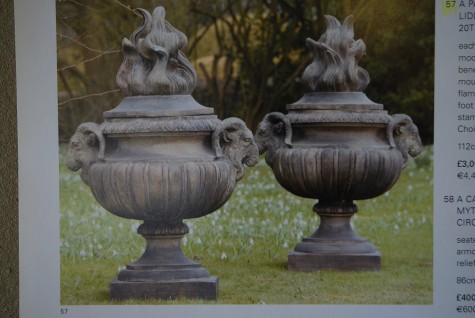 In one of their garden ornament auction catalogues published nearly a decade ago, Sotheby’s offered a pair of early twentieth century stoneware lidded urns. The cataolgue description was as follows: “each lobed body with boldly modelled ram’s heads beneath egg and dart moulded everted rim, and flaming lids on rising circular foot and square base, stamped A Brault File, Choisy-le-Boi.” Flaming lids? This alone was enough to make fall for them. More formally speaking, a flambeau is a torch, or flame. As a decoration, a flambeau is a flame shape; one sometimes sees these flames springing from an urn, or finial.
In one of their garden ornament auction catalogues published nearly a decade ago, Sotheby’s offered a pair of early twentieth century stoneware lidded urns. The cataolgue description was as follows: “each lobed body with boldly modelled ram’s heads beneath egg and dart moulded everted rim, and flaming lids on rising circular foot and square base, stamped A Brault File, Choisy-le-Boi.” Flaming lids? This alone was enough to make fall for them. More formally speaking, a flambeau is a torch, or flame. As a decoration, a flambeau is a flame shape; one sometimes sees these flames springing from an urn, or finial.
 The flame was often used as a decorative element in antique urns and finials. This Coadestone lidded urn has the date 1795 stamped into the base. The word finial comes from the latin-finis, or finish. A garden finial is a sculpted ornament that terminates or finishes some architectural element, such as gate piers, or fence piers.
The flame was often used as a decorative element in antique urns and finials. This Coadestone lidded urn has the date 1795 stamped into the base. The word finial comes from the latin-finis, or finish. A garden finial is a sculpted ornament that terminates or finishes some architectural element, such as gate piers, or fence piers.
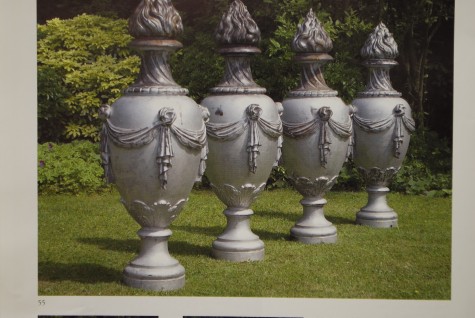 This quartet of cast iron finials auctioned at about the same time are late nineteenth century. Voluptuous in shape with fluid and gracefully rendered drapery, the flaming lids look more to my eye like some fabulous hairdo. At 49 inches high, they are not for the faint of heart. Even the color is spectacular-for all the world they look like they had been painted with aluminum or silver paint. It would take a garden of considerable size and self assurance to take take them on. Though I cannot imagine placing them, I would have them in a heartbeat. They are rowdy, and outrageous. Gorgeous and elegant.
This quartet of cast iron finials auctioned at about the same time are late nineteenth century. Voluptuous in shape with fluid and gracefully rendered drapery, the flaming lids look more to my eye like some fabulous hairdo. At 49 inches high, they are not for the faint of heart. Even the color is spectacular-for all the world they look like they had been painted with aluminum or silver paint. It would take a garden of considerable size and self assurance to take take them on. Though I cannot imagine placing them, I would have them in a heartbeat. They are rowdy, and outrageous. Gorgeous and elegant.
 Happily, a pair of antique English sandstone flambeau lidded urns arrived on this container. They were of a size and age that made careful crating necessary. A good bit of the cost of any garden ornament is the expense associated with the shipping. In this case, a piece of furniture needed to be built to get the pieces here safely.
Happily, a pair of antique English sandstone flambeau lidded urns arrived on this container. They were of a size and age that made careful crating necessary. A good bit of the cost of any garden ornament is the expense associated with the shipping. In this case, a piece of furniture needed to be built to get the pieces here safely.
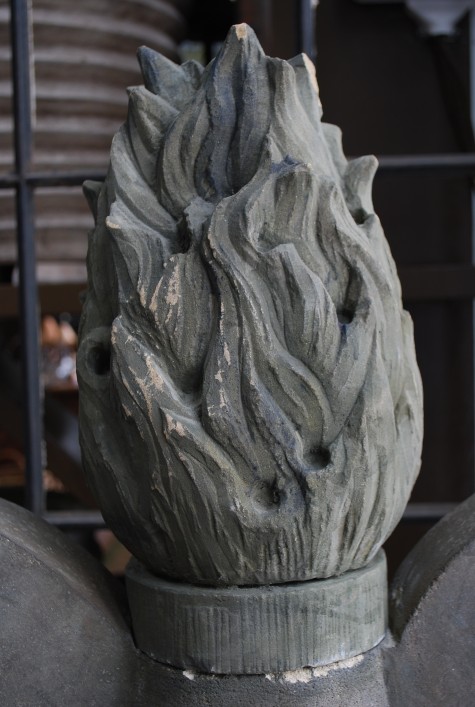
My flaming lids are carved in a similar fashion to the aforementioned French finials, but in a less refined style. This pair of antique English sandstone flambeau finial urns came originally from a Victorian manor house in Derbyshire, England, in Chatsworth House county. Afficianados of anything English are familiar with Chatsworth; it is a much celebrated and admired garden.
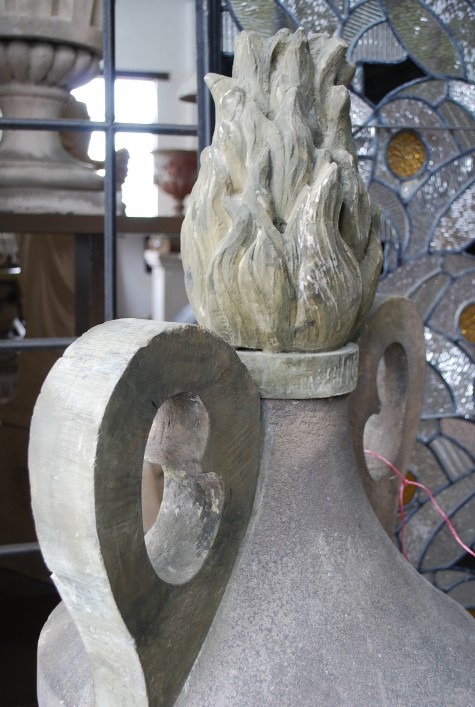 The handles are very large, and simply carved from a single piece of sandstone. Small chips on the sharp edges of the stone consistent with its age reveal the original ochre color of the stone. The shape of this finial, the handles and long narrow neck bring to mind the shape of an amphora. From the Greek, “amphi”, meaning on both sides, and “phoreus”, referring to the handles by which the vessel would be carried. This is strictly my imagination at work here.
The handles are very large, and simply carved from a single piece of sandstone. Small chips on the sharp edges of the stone consistent with its age reveal the original ochre color of the stone. The shape of this finial, the handles and long narrow neck bring to mind the shape of an amphora. From the Greek, “amphi”, meaning on both sides, and “phoreus”, referring to the handles by which the vessel would be carried. This is strictly my imagination at work here.
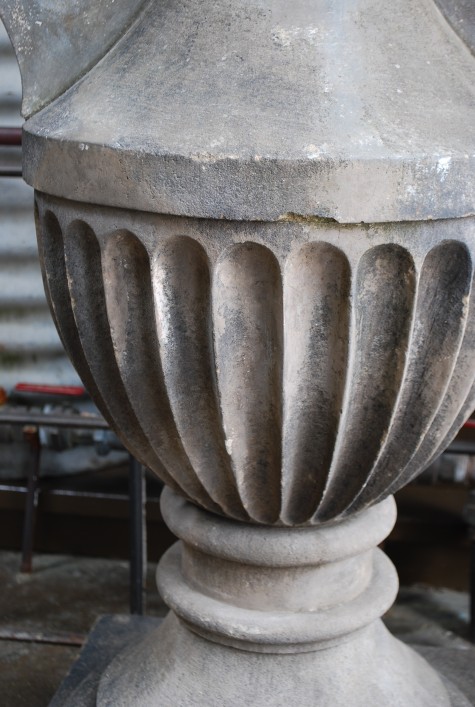 The body of the finial is unexpectedly, and beautifully fluted. All five foot 6 inches of the stone rests on a waisted socle and circular foot. The stepped square base at the bottom is generously proportioned and thick.
The body of the finial is unexpectedly, and beautifully fluted. All five foot 6 inches of the stone rests on a waisted socle and circular foot. The stepped square base at the bottom is generously proportioned and thick.
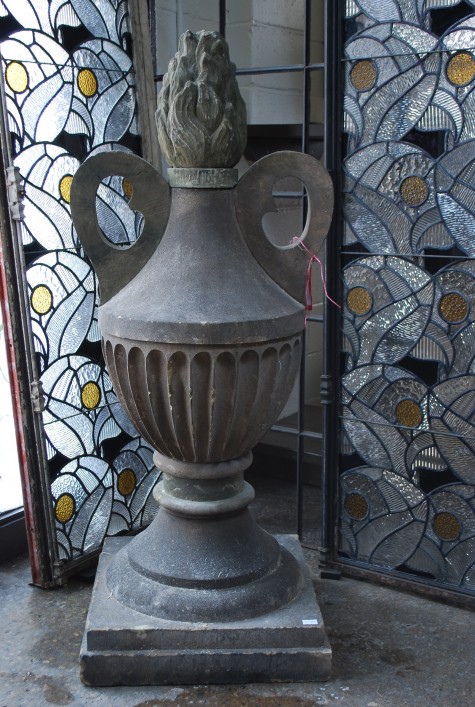
Statuesque comes to mind. I find the simple shapes and proportions very pleasing to the eye. Though massive and heavy, I could see these finials fitting into a landscape quite gracefully. I could not be more pleased to have them.
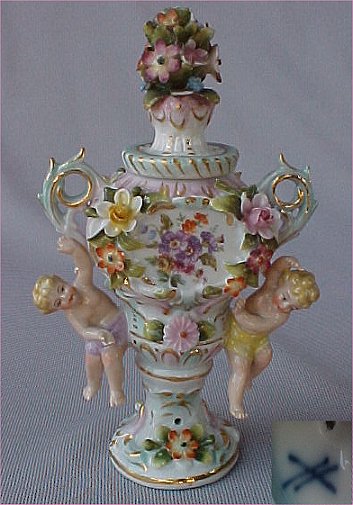 I did not post this picture of a capodimonte porcelain lidded urn solely from worry that this essay might be making you sleepy. If you look at the picture, and squint your eyes enough so the cherubs and surface decoration fades, you will see the flame finial and this urn share certain common elements. They could not be more different in material, surface, effect, size, color, texture and purpose-but they do share a certain something.
I did not post this picture of a capodimonte porcelain lidded urn solely from worry that this essay might be making you sleepy. If you look at the picture, and squint your eyes enough so the cherubs and surface decoration fades, you will see the flame finial and this urn share certain common elements. They could not be more different in material, surface, effect, size, color, texture and purpose-but they do share a certain something.
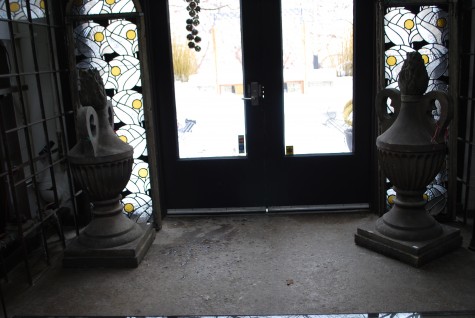
I have given them a special place at the front door. I think the 1920’s stained glass doors set off my flaming lids quite well, don’t you?
Do you need to seal the sandstone before you set those out in our freeze/thaw environment? Or would you advocate setting those under a roof somewhere?
Dear Jenn, this is a really good question. Any great antique garden ornament needs first rate winter care. I would not seal the sandstone, but I would elevate it off the surface on which it sits. I have seen trapped water that froze destroy an antique steel cistern. The sandstone would be child’s play. Deborah